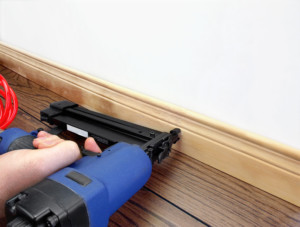 When redoing hardwood floors, baseboard trim is typically an afterthought. However, adding baseboard trim, or replacing outdated baseboard moldings, can be an inexpensive way to change the look and feel of your home. With all of the available materials and styles, how will you know which will work best in your home? Here is an overview of the options, so you can make an informed decision when the time comes.
When redoing hardwood floors, baseboard trim is typically an afterthought. However, adding baseboard trim, or replacing outdated baseboard moldings, can be an inexpensive way to change the look and feel of your home. With all of the available materials and styles, how will you know which will work best in your home? Here is an overview of the options, so you can make an informed decision when the time comes.
Different Styles of Baseboard Trim
The first thing you need to consider when deciding on baseboard trim is the style of your home. Some baseboard molding styles will work well in most styles of home, but other types may look out of place. For example, crown and casing trim profiles go well in a Neoclassical style home or a home with tall ceilings, but such a style would definitely clash in a more contemporary or modern home. If you are unsure what styles might work in your home a helpful first step might be to reference an architectural magazine or go online to get an idea of what your home’s style is.
Location of the Trim or Baseboard Molding Within the Home
It is also important to consider the type of room the baseboard moldings will go in. A material or style that works in a bathroom or kitchen, may not be suitable for a bedroom or living room. Additionally, sometimes it makes sense to use a trim or molding consistently from one room to the next, but depending on the surface area, intricacy and/or price, some options are best left for the main living or entertaining areas of the home vs. the entire house.
Baseboard Trim & Molding Material
After you determine the style of your home, you will need to decide which type of trim/molding material works best with your space and your flooring. Common materials for baseboard trim include medium density fiberboard (MDF), pine, and hardwood.
-
MDF Baseboard Moldings & Trim
MDF has a consistent texture, which makes it easy to cut and sculpt into a variety of different shapes. If you plan to paint your baseboard trim, MDF is a great, budget-friendly option. However, if you are looking to stain your trim or need your trim to match existing trim in your home you may need to consider using wood.
-
Pine Baseboard Trim
Pine is a great choice for those who want to use wood trim, but don’t have the budget for hardwood. Pine is very versatile wood and can be painted or stained, depending on your needs. If you choose pine, you will want to look for molding that is smooth and free of knots and blemishes, which could cause it to splinter when cut.
-
Hardwood Baseboard Moldings
Although hardwood tends to be the most expensive option for baseboard trim, it is also the highest quality and the best option to consider if you are redoing hardwood floors in your home. Additionally, if you need to match existing trim in your home or are trying to get an exact stain, hardwood offers tremendous flexibility. You can find baseboard profiles in almost any type of hardwood and there are a number of companies that will customize it to your preferences.
Baseboard Molding Size
The size and height of the room will help you determine how large you want your baseboard molding. A simple rule of thumb from SFGATE Home Guides is to keep your baseboard trim to 3 to 5 inches for a standard 8-foot ceiling and 5 to 7 inches for a 10-foot ceiling. If your home is very large or has ceilings over 10 feet, you may want to consider an even taller baseboard trim. If you do use a tall baseboard trim, you may want to use a simpler trim for the rest of the room, as something like crown molding could cause the room to seem off balance.
Baseboard trim and moldings are an important, yet often overlooked, detail of the home. Done correctly, or alongside the process of redoing your hardwood floors, trim and molding choices can balance a room and create a subtle elegance without a huge expense.






